Flank steak is my go to steak when cooking for a larger party of friends at the house; particularly in the summer when I can finish it on the grill. It has such robust flavor and becomes nicely tender with a delightful bit of chew through the magic of sous vide.
The large flat shape gives it a lot of surface area for some great char, as well as lends itself to slicing up to serve easily for a party.
Served in fajitas, atop a salad or on its own, this Mexican inspired sous vide flank steak recipe is as sure to please as it is versatile.
- Related article: How Much Steak Per Person – Steak Sizes & Portions By Cut

Table of Contents
Steak Trimming Notes
If you find a strip of fat running along the side of the steak, we’d trim it to 1/4 inch thick or less before you sous vide; There’s no need to fret over getting the thickness of the fat even. Try not to cut into the meat when trimming.
If you’re dealing with an untrimmed flank steak, trim fat down to a quarter inch. Also remove the silver skin membrane, which will be on one side. The tip of your knife is a convenient and effective way to loosen the membrane. Use a paper towel to grip the membrane.
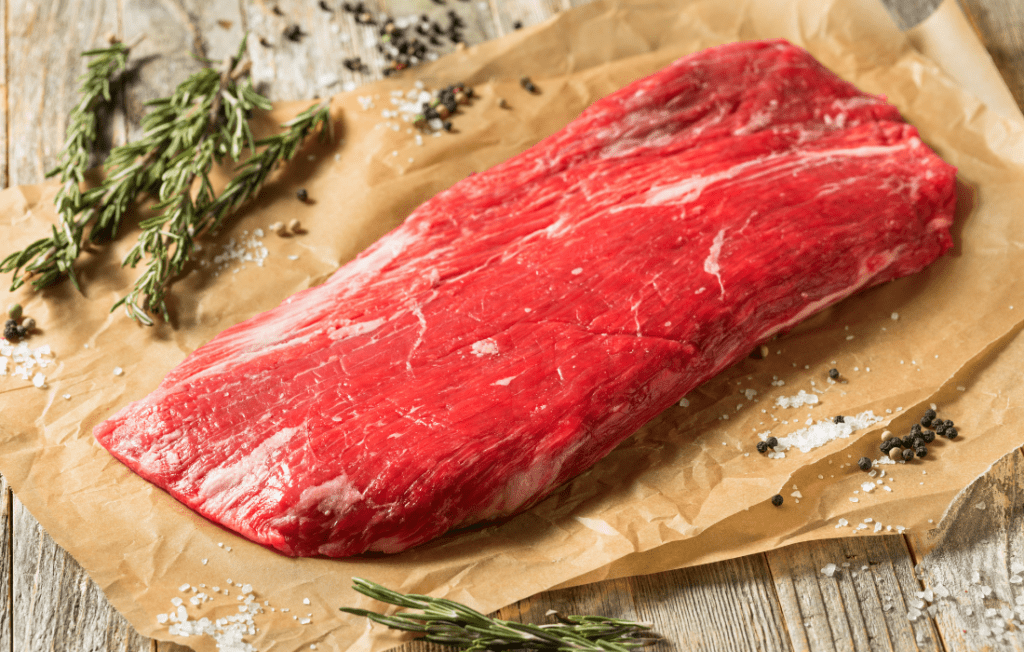
Immersion Prep
The basic premise of sous vide cooking utilizes an airtight bag submerged in water to cook at low temperatures for longer periods of time. This type of water immersion technique cooking method requires that sous vide foods are put into watertight tight sealed bags, devoid of as much air as possible.
There are two common practices to bag foods appropriately to cook sous vide: using a vacuum sealer and the water displacement method.
A vacuum sealer is the optimal method to ensure all air is removed from the bag with a tight seal. You can find the right vacuum sealer for you here.
The water displacement method is an effective and convenient method that can be used with Ziploc or silicone bags. After filling the bag with the appropriate food contents, you lower the bag into the water to displace the air out of the bag and seal on the follow.
Either method can be used for this recipe sous vide.
Cooking Time and Temperature
Our preferred time and temperature for sous vide flank steak is 133°F (56.1°C) for 18 hours. Sure, you could cook it in as little as 2 hours, but extended sous vide cooks do wonders on naturally tougher cuts like flank steak. This leads to a tenderized perfectly even rosy medium-rare finish. The minimum time we like to use is 12 hours. The longest we’d go is 48 hours to further soften the mouth feel. See reference guide below to adjust the time and temperature to your liking.
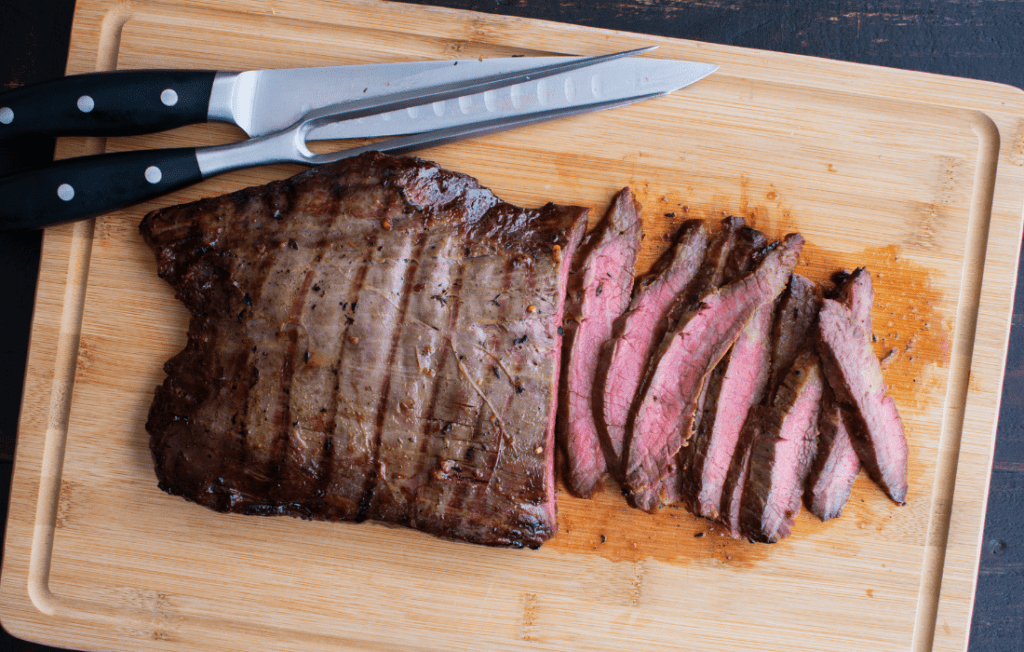
Flank Steak Sous Vide Temperature & Time Chart
Keep in mind the sear will raise the internal temperature ~3°F. We generally prefer 18-24 hours.
| Target Doneness | Temp Range | Cook Time |
| Very rare to rare + | 120°F (49°C) to 129°F (54°C) | 1 – 2.5 hours |
| Medium-rare | 130°F (54°C) to 135°F (57°C) | 2 – 48 hours |
| Medium | 136°F (57°C) to 142°F (61°C) | 2 – 48 hours |
| Medium-well | 143°F (61°C) to 155°F (68°C) | 2 – 48 hours |
| Well done | 156°F (69°C) + | 2 – 18 hours |
Sear to Finish Steak
Searing is critical to having your steak be plate ready. Not only does the searing process add color to the dish, but also adds depth of flavor, texture and locks in juices.
The critical steps to get a great crust are:
- Dry the meat thoroughly by patting with a paper towel
- Season the meat generously with seasoning such as salt and pepper
- Use extremely high heat
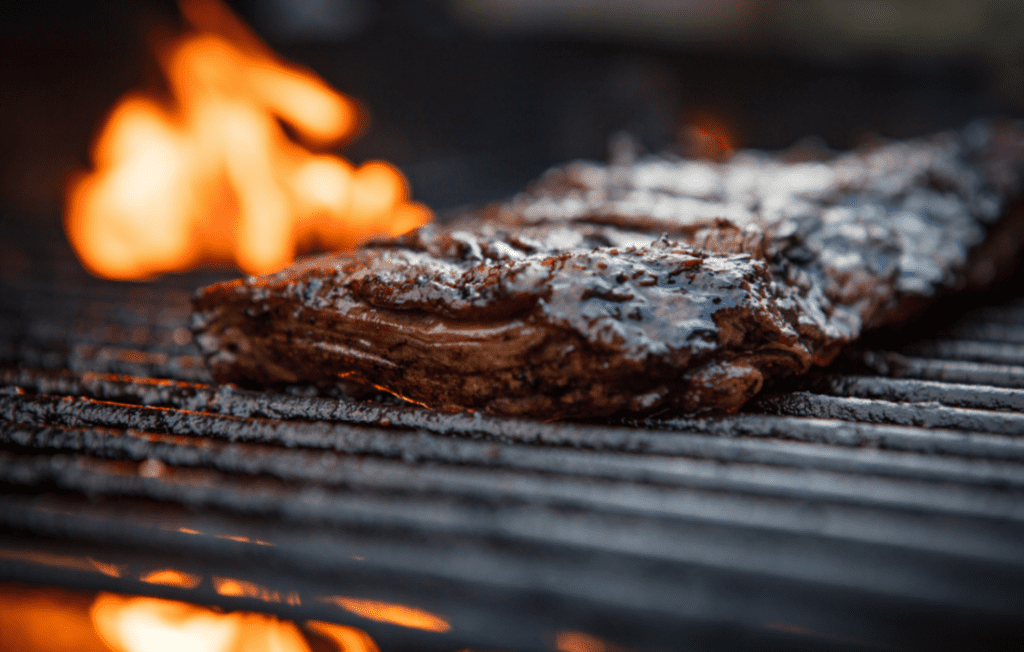
The first step is easy to forget but crucial. Failure to pat the meat dry inhibits the Maillard reaction needed to create a crust. Seasoning the meat adds flavor and induces the crust. Lastly, using extremely high heat creates the crust.
The three methods we would suggest for the high temperature sear are:
- Pan searing, preferably using cast iron
- Grilling
- Using a searing torch
You’ll want to sear for 1 to 2 minutes per side. The less time taken to reach your desired crust, the better. If pan searing, we prefer ghee (clarified butter) or a high smoke point oil such as avocado oil, but regular butter will do. Limiting to the sear to 2 minutes per side should prevent the steak from overcooking.
It requires marginally more work, but searing the steak for 30 seconds to a minute per side, 2 (or more) times each can add more color and texture and further prevent overcooking.
In the searing stage we’re doing our best to preserve the perfectly even doneness of the sous vide meat, while adding color, texture and taste to further its appeal.
Carving
Carving a flank steak isn’t all that complicated, just make sure to cut against the grain to create a tender bite. Cutting with the grain will create extra chew. I prefer half inch thick slices on a flank steak when served as a standalone main dish, thinner if for fajitas, and some form of chopped for tacos and salads.
With carving we’re just aiming to maximize the tenderness by minimizing the chew.
Where to Find Quality Flank Steak
Flank steak is a common cut that can often be found at the grocery shop but surely can be found at your local butcher.
If you haven’t ordered online at Crowd Cow, I’d encourage you to try it. They have a large selection of high-quality meats and operate under the core tenents of taste, transparency and convenience.
Crowd Cow connects you to 100+ small farms across 23 states. The selection ranges from competitively priced grocery store staples to restaurant quality craft and heritage meats.
Kitchen Equipment Needed
If you’re new to sous vide, we have a great post on sous vide starter kits to get you going equipment wise. Below we summarize the essentials.
Immersion Circulator
A sous vide cooker is the one piece of equipment that is critical to purchase to cook sous vide. It’s a portable machine that clamps onto a container to circulate, heat and regulate the water bath to the desired temperature.
Immersion circulators include the Anova Sous Vide Precision Cooker series and the Breville Joule Sous Vide Cooker. For a more complete comparison of sous vide cookers see our review of the 10 best sous vide machines.
Sous Vide Container
You don’t technically need a separate container and can use any metal pot at home, but I prefer a sous vide container. They’re lightweight, transparent and designed with sous vide cooking in mind.
We’ve reviewed the best sous vide containers to help you find one that best meets your needs.
Vacuum Sealer
If you’re serious about sous vide, a vacuum sealer deserves serious consideration. A vacuum sealer will eliminate the vast majority of sous vide bag issues that can cause your sous vide cook to go wayward.
Bonus, it will benefit you well beyond sous vide and likely pay for itself in short order. Check out our research on the best sous vide vacuum sealers.
Cast Iron Skillet
Not really unconventional, but if a cast iron skillet isn’t a part of your kitchen arsenal, it should be for sous vide. The heat retention of cast iron will go along way in pan searing, which is the most common and versatile form of searing sous vide cooked food.
Lodge makes a great and affordable cast iron skillet. I’d go with an oversized searing skillet to accommodate larger cuts of meat, but a standard size searing skillet will do just fine in most cases.
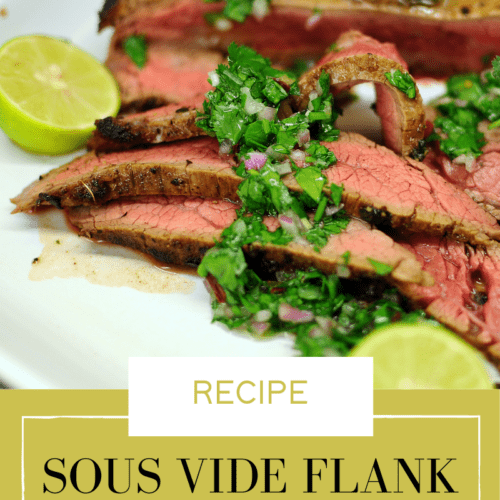
Sous Vide Flank Steak Recipe
Equipment
- Sous Vide Cooker
- Sous Vide Container
- Vacuum Sealer optional
- Vacuum Seal Bags or Ziploc like bags
- Skillet, grill, or oven (broiler)
Ingredients
- 2 lb flank steak
- 1/4 cup fresh squeezed lime juice
- 1/4 cup pineapple juice
- 1/4 cup soy sauce
- 1 clove garlic
- 1 tbsp fresh ground pepper
- 2 each chiles de arbol crushed
- 1/4 cup ghee can substitute olive oil for the grill or butter for the pan
Instructions
- Set the sous vide machine to 133°F / 56.1°C to preheat the water.
- Bag the flank steak with lime juice, pineapple juice, soy sauce, garlic, and crushed chiles de arbol. salt, pepper, garlic and rosemary and thyme sprigs.
- Seal the bag and cook in the sous vide container for 18 hours.
- When the flank steak is ready, take it out of the container and place the vacuum sealed bag in the freezer for 10-15 minutes.
- Take the flank steak out of the vacuum sealed bag and pat it dry.
- Rub ghee all over the flank steak. Finish with very high heat on a grill or pan 1 to 2 minutes per side. Use apple or pecan wood if applicable to your grill. A broiler may be used too if the steak is too large for your pan.
- When ready to eat, finish with salt and be sure to slice the steak against the grain. Enjoy your perfectly cooked flank steak immediately!
Notes
Beverage Pairing
Like most steak, we’d recommend red wine as a perfect beverage pairing for this meal, particularly if you plan to serve it as the stand alone main. Reds with a medium tannin structure pair beautifully with the lean yet robust flavor of flank steak; Malbec, Sangiovese and Merlot are great choices.
If used in fajitas or tacos, dark lager beers and margaritas go well.
For a non-alcoholic option, use pomegranate juice on its own or for the base of a fun mocktail.
Additional Flank Steak Information
Other Names for Flank Steak
Flank steak also goes by London broil. You may have heard the of the cut bavette, which is the French term for flank steak.
Though different cuts, flank steak and skirt steak are often used interchangeably. Skirt steak is a also comes from the abdominal wall of the cow, but is a bit tougher as it comes from the diaphragm.
Anatomy
The flank steak comes from the belly of the cow, just forward of the rear quarter of the cow and just behind the chest plate.
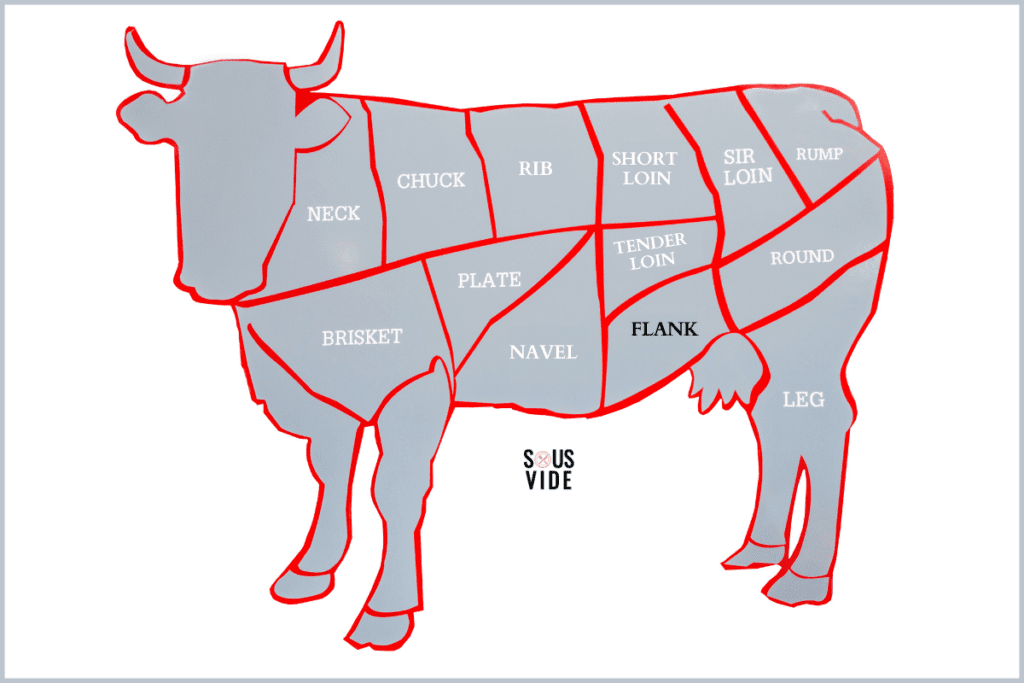
The cow uses its belly muscles frequently, making this a rather lean and flavorful cut. The flank steak is typically the whole abdominal muscle of the cow roughly 1 inch thick and 1 foot long.
Flank Steak Sous Vide FAQs
We like 18 hours cooking sous vide for flank steak, though you can go as short as 2 hours or as long as 48 hours. The longer you cook, the more tender the naturally tough meat will become. We view 18-24 hours as the sweet spot.
We prefer 133°F (56.1°C). Given how lean flank steak is, we wouldn’t go higher than 137°F (58.3°C).
The length of time for cooking is far more forgiving in sous vide than any other form of cooking. The meat will become more tender the longer you cook it, but at some point that becomes self defeating as the meat becomes mushy. We wouldn’t go longer than 48 hour on a flank steak.
As far as temperature goes, 137°F (58.3°C) is as high as we’d go given how lean the meat is.
The short answer is yes when using a sous vide. At some point it gets too tender and starts to fall apart.
Both the flank and skirt steaks come from the abdominal wall of the cow. The skirt steak comes from the diaphragm and is thinner and tougher.
If you’re in the mood for an interesting short read, see The Colonel in the Kitchen: A Surprising History of Sous Vide.
Other Sous Vide Steak Recipes
Check out other great sous vide steak recipes:
Only question for you before you get started. Do you know how to tell if steak is bad? We’re not into putting you in the hospital.


I love flank steak because it’s lean, but it’s always been tough to find a way to cook them to make them more tender. Sous vide is definitely a good option.